Sola Busca tarot
The Sola Busca tarot is the earliest completely extant example of a 78-card tarot deck. It is also the earliest tarot deck in which all the plain suit cards are illustrated[1][2] and it is also the earliest tarot deck in which the trump card illustrations deviate from the classic tarot iconography. Unlike the earlier Visconti-Sforza tarot decks, the cards of the Sola Busca are numbered. The trump cards have Roman numerals while the pips of the plain suits have Hindu Arabic numerals.The deck was created by an unknown artist and engraved onto metal in the late 15th century. A single complete hand-painted deck is known to exist, along with 35 uncolored cards held by various museums.[3] The deck is notable not only for its age, but also for the quality of its artwork, which is characterized by expressive figures engraved with precise contours and shading.[4] Various theories have been suggested about who created the deck, but its authorship remains uncertain.[3][5]

Composition
The Sola-Busca deck comprises 78 cards including 21 trumps (trionfi) plus the Fool (Matte) and 56 suit cards. There had been many previous decks structured in this way.[6] The names and illustrations on the trump cards in the Sola Busca are somewhat idiosyncratic for its time.The departure from classic trump iconography in the Sola Busca is a trait shared by later French suited tarot decks such as the Bourgeois Tarot and the Industrie und Glück Tarock decks.
The characters depicted in the Sola-Busca cards include Nebuchadnezzar and Gaius Marius, the uncle of Julius Caesar. Trump cards loosely follow the rise and fall of the Roman Empire but also include members of the Roman Pantheon such as Bacchus. All the characters can be easily linked to their equivalents in the earlier and later, more standard, decks.
Painted deck
The complete painted deck is currently housed at the Brera Museum in Milan. It can trace its provenance to the noble Busca-Serbelloni family. In the early 19th century the deck was owned by Marchioness Busca (born Duchess Serbelloni) of Milan.[1] In 1907, the Busca-Serbelloni family donated black-and-white photographs of all 78 cards to the British Museum, where they were likely seen by A. E. Waite and Pamela Colman Smith, inspiring the subsequent Waite-Smith tarot deck.[7] From 1948, the deck was owned by the Sola-Busca family, from which it received its name.[1] In 2009, the deck was purchased for €800,000 by the Italian Ministry of Cultural Heritage and Activities and delivered to the Brera Museum.[1][8]
Unpainted cards
Thirty-five unpainted cards are also known. The Albertina museum in Vienna owns 23, including all of the trumps except the first and last, Mato and Nabuchodenasor.[9] The 20 trump cards originally belonged to Count Moritz von Fries, while the other three came from the Imperial Court Library.[10]
The British Museum owns four unpainted cards, which it purchased from William and George Smith in 1845.[3] Four unpainted cards are also housed in Hamburg and Paris.[3]
Impact
The similarities between the artwork of the Minor Arcana of the Waite-Smith deck and Sola-Busca's plain suits has led some scholars to suggest that artist Pamela Colman Smith drew inspiration from the earlier work.[2] Smith created the art for her deck two years after the acquisition of photographs of the Sola-Busca deck by the British Museum, and likely saw the cards on display there. Notable similarities include the Three of Swords card and the Ten of Wands card in the Rider deck, which is very similar to the Ten of Swords card in the Sola-Busca deck.[7]
Research
In 1938, Arthur Mayger Hind described the Sola Busca Tarot in his Early Italian Engravings and supposed that the deck was engraved around 1490 and then hand-painted in 1491, as a result of reading some of the inscriptions on the cards. He also supposed that the deck was created for a Venetian client by Mattia Serrati da Cosandola, a miniaturist operating in Ferrara (the center of Tarot card production at the time). In fact, many inscriptions on the cards refer without any doubt to the Republic of Venice.[11]
In 1987, in the catalogue of a great Tarot exhibition realized at the Estense Castle of Ferrara, Italian historian Giordano Berti wrote a summary of all the research made up to that point by various scholars.[12]
In 1995 the Italian scholar Sofia Di Vincenzo, in her book titled Antichi Tarocchi illuminati. L’alchimia nei Tarocchi Sola-Busca (Turin, 1995 and Stamford, 1998), argued that many images of the Sola Busca deck are related to themes of European alchemy as practised during the Renaissance.[13]
In 1998, the German publisher Wolfgang Mayer printed, for the first time, a faithful version of the 78 cards in a limited edition of 700 numbered copies.
In 2012 the Pinacoteca di Brera organized the exhibition Il Segreto dei Segreti - I Tarocchi Sola Busca e la cultura ermetico-alchemica. In the catalog, the possible author of the engravings, Nicola di Maestro Antonio, the possible inspirer, the hermeticist Ludovico Lazzarelli, the year and place of execution of the color version, Venice in 1491, are suggested. Furthermore, it has been established in an irrefutable way that the Sola Busca Tarot is linked to the hermetic-alchemical tradition. The key figure is the King of Swords, titled Alecxandro M. (Alexander the Great), who according to a legend, reported in the medieval book entitled Secretum secretorum, was initiated into alchemy by his master, the philosopher Aristotle. In addition to Alexander the Great there are other characters linked to the hermetic-alchemical tradition. The Knight of Swords, Amone, refers to Zeus Ammon, the mythical putative father of Alexander who welcomed him in the Siwah Oasis. The Queen of Swords, Olympias, Alexander's mother, was known as a sorceress. The Knight of Cups, Natanabo, (Nectanebo), was an Egyptian priest and magician. Prof. Gnaccolini, inspired by the study of Sofia Di Vincenzo, cites many other explicit alchemical allegories. [14]
Trump suit
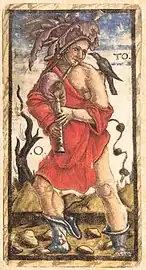 0 – Mato
0 – Mato I – Panfilio
I – Panfilio II – Postumio
II – Postumio III – Lenpio
III – Lenpio IV – Mario
IV – Mario V – Catulo
V – Catulo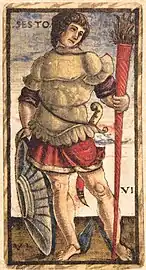 VI – Sesto
VI – Sesto VII – Deo Tauro
VII – Deo Tauro VIII – Nerone
VIII – Nerone IX – Falco
IX – Falco X – Venturio
X – Venturio XI – Tulio
XI – Tulio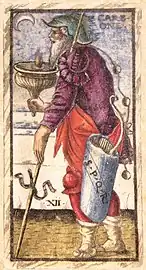 XII – Carbone
XII – Carbone XIII – Catone
XIII – Catone XIIII – Bocho
XIIII – Bocho XV – Metelo
XV – Metelo XVI – Olivo
XVI – Olivo XVII – Ipeo
XVII – Ipeo XVIII – Lentulo
XVIII – Lentulo XIX – Sabino
XIX – Sabino XX – Nenbroto
XX – Nenbroto XXI – Nabuchodenasor
XXI – Nabuchodenasor
Plain suits
Cups
 Ace of Cups
Ace of Cups Two of Cups
Two of Cups Three of Cups
Three of Cups Four of Cups
Four of Cups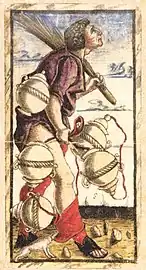 Five of Cups
Five of Cups Six of Cups
Six of Cups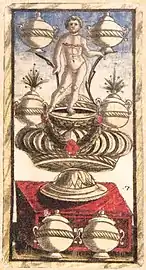 Seven of Cups
Seven of Cups Eight of Cups
Eight of Cups Nine of Cups
Nine of Cups Ten of Cups
Ten of Cups Knave of Cups
Knave of Cups Knight of Cups
Knight of Cups Queen of Cups
Queen of Cups King of Cups
King of Cups
Coins
 Ace of Coins
Ace of Coins Two of Coins
Two of Coins Three of Coins
Three of Coins Four of Coins
Four of Coins Five of Coins
Five of Coins Six of Coins
Six of Coins Seven of Coins
Seven of Coins Eight of Coins
Eight of Coins Nine of Coins
Nine of Coins Ten of Coins
Ten of Coins Knave of Coins
Knave of Coins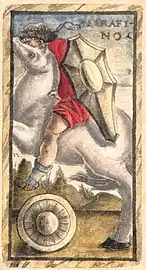 Knight of Coins
Knight of Coins Queen of Coins
Queen of Coins King of Coins
King of Coins
Batons
 Ace of Batons
Ace of Batons Two of Batons
Two of Batons Three of Batons
Three of Batons Four of Batons
Four of Batons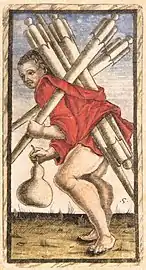 Five of Batons
Five of Batons Six of Batons
Six of Batons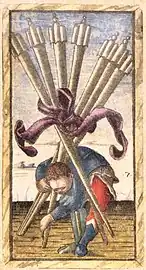 Seven of Batons
Seven of Batons Eight of Batons
Eight of Batons Nine of Batons
Nine of Batons Ten of Batons
Ten of Batons Knave of Batons
Knave of Batons Knight of Batons
Knight of Batons Queen of Batons
Queen of Batons King of Batons
King of Batons
Swords
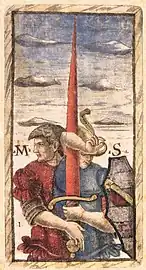 Ace of Swords
Ace of Swords Two of Swords
Two of Swords Three of Swords
Three of Swords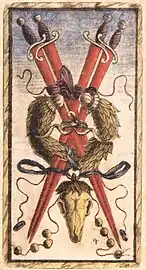 Four of Swords
Four of Swords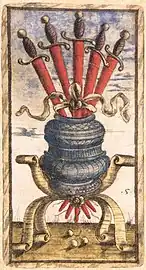 Five of Swords
Five of Swords Six of Swords
Six of Swords Seven of Swords
Seven of Swords Eight of Swords
Eight of Swords Nine of Swords
Nine of Swords Ten of Swords
Ten of Swords Knave of Swords
Knave of Swords Knight of Swords
Knight of Swords Queen of Swords
Queen of Swords King of Swords
King of Swords
References
- Berti, Giordano (2013). "History of Sola-Busca Tarot". Sola-Busca Tarot Mayer 1998. Retrieved 10 April 2020.
- Kaplan, Stuart (1990). Encyclopedia of Tarot. Vol. 3. U.S. Games Systems. p. 30. ISBN 0880791225.
- "Collection online". British Museum. Retrieved 23 March 2020.
- Zucker, Mark J. (1997). "The Master of the 'Sola-Busca Tarocchi' and the Rediscovery of Some Ferrarese Engravings of the Fifteenth Century". Artibus et Historiae. 18 (35): 181–194. doi:10.2307/1483546.
- Bezzone, Francesca (5 April 2019). "Mystery and history of art merge together in the Sola Busca tarots". L'Italo-Americano. Retrieved 11 April 2020.
- Dummett, Michael (1980). The Game of Tarot: From Ferrara to Salt Lake City. University of California: Duckworth.
- Berti, Giordano (2013). "Sola-Busca & Waite-Smith Tarot". Sola-Busca Tarot Mayer 1998. Retrieved 10 April 2020.
- Panza, Pierluigi (16 February 2010). "I tarocchi per rilanciare Brera". Corriere della Sera (in Italian). p. 39. Archived from the original on 15 June 2015.
- Kaplan, Stuart (1990). Encyclopedia of Tarot. Vol. 2. U.S. Games Systems. p. 297. ISBN 0880791225.
- Willshire, William Hughes (1876). A Descriptive Catalogue of Playing and Other Cards in the British Museum. Chiswick Press. pp. 77–78.
- Hind, Arthur (1938). Early Italian Engravings. pp. 241–247, 370–393.
- Berti, Giordano (1987). Le Carte di Corte. Gioco e Magia alla Corte degli Estensi. Bologna: Nuova Alfa Editoriale. pp. 88–91. ISBN 88-7779-016-4.
- Di Vincenzo, Sofia (1998). Sola Busca Tarot. Stamford: U.S.Games Systems. pp. 25–33. ISBN 1-57281-130-7.
- Various, authors (2012). Il Segreto dei Segreti - I Tarocchi Sola Busca e la cultura ermetico-alchemica tra Marche e Veneto alla fine del Quattrocento. Milan: Skira. ISBN 978-88-572-1764-2.